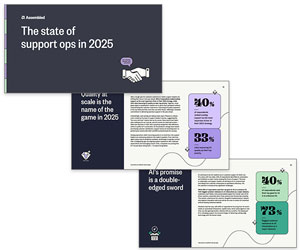If you’re working in planning and struggling to get through to your key stakeholders and colleagues, it’s probably time for a fresh approach.
That’s why our Editor, Megan Jones, spoke to Alec Bowman-Clarke, Danny Gunn, and Sarah Thompson to find out how to turn WFM data into a compelling story and become a trusted voice in the contact centre.
Here’s what they said…
1. Don’t Just Chuck Graphs and Numbers Out There
One of the biggest mistakes planners can make is just chucking the numbers out there, as Sarah Thompson, Senior Planning and Insight Lead, explains,
“If you just chuck the numbers out there, you’ve lost your audience already! Quite frankly, if your graph has got more than two or three data points on it, it’s too much!”
“Instead, think about what your stakeholders really need to see in that moment. I really hate sensory overload graphs, so one of the things I say to my team all the time is, “I’ve only got 2 minutes, what do I need to know from that graph?”. If they can’t answer it quickly, they know there’s too much information on it.”
2. Always Be Honest! Building Trust With Stakeholders Makes Life Easier in the Long Run
It isn’t always about delivering good news; sometimes, the job involves conveying tough truths, and doing so is essential to making sure your voice is heard and respected.

“The key is to transform raw numbers into a meaningful narrative without softening the edges to make it more palatable.
Being bold, brave, and honest is vital, even when it means handling emotional reactions.
For example, no one wants to hear that a Service Level Agreement (SLA) is on the verge of being breached, risking regulatory fines or executive criticism.
Delivering this news can be daunting, and the temptation to dilute the message is strong. However, by earning the trust of your peers and becoming a reliable advisor, your honesty will be valued.
Sometimes it’s about enduring short-term pain for long-term gain and being a good enough storyteller to bring your audience with you on that journey.” – Alec Bowman-Clarke, WFO Consultant
For advice on improve internal communication, with ideas, real-life examples, and mistakes to avoid, read our article: 7 Clever Ways to Improve Internal Communication Between Departments
3. Try a Little and Often Approach to Make Insights More Digestible
It really helps to remember that you’re trying to relay a lot of information to really busy people, so it’s important to find a method that makes this as easy as possible for everyone involved.
One way to do this is to take a little and often approach, as Danny Gunn, Head of Workforce Planning, explains,
“When you’ve got lots of contact centres to report on, sharing a big update once a month or even once a quarter can just get lost in the ether. To help keep the leadership team updated in smaller bites, we’ve created what we call our Global Operational Daily Reports as a regular point of communication.”
You also need to make sure you are conveying your message in the right way. For advice on this, read our article: The 7 Cs of Effective Communication
4. Make the Data Relevant to What Your Stakeholders Care About
Don’t just talk about the raw numbers and percentage differences in your data, tell your stakeholders what that means for them.
“You need to take the information in your graphs to the next level by taking that information and making it relevant to people. For example, explaining to your board what impact your numbers will have on the bottom line. Tell the story that makes it relevant to what they care about.” – Sarah Thompson
5. Take Accountability for the Data
When sharing your data findings, avoid taking a “don’t shoot the messenger” approach, as it can have negative long-term consequences.
“Someone needs to take accountability for the meaning behind the numbers, and that someone is you! Emphasize that your critical insights enable decision-makers to make choices that can resolve issues effectively.
Yes, you might face raised voices or eyebrows, but decision-makers will come to listen to and rely on your insights even more if you have the courage to share both the bad and the good news.” – Alec Bowman-Clarke
6. Inject Passion Into Your Presentations
How you convey your data’s story isn’t just about the strength and clarity of your presentation, it’s about how engaging you are too!

“Showing a bit of charm and passion can go a long way! Yes, a good presentation will help, but it’s also to do with you too!
If you’re confident and passionate about what you’re saying, you’re going to have much more of an impact, and people are going to remember that.
They’re going to be a lot more interested compared to somebody just droning on about numbers and reading off a screen.” – Sarah Thompson
7. Get Different People Together to Pull Out the Story
Don’t go it alone either, as Danny Gunn shares:

“I like to have a weekly handover session where I get together with my intraday team, planning team, and forecasting team, and we pull out what we think the story and direction of travel is for the coming weeks.
Together, we can put together a compelling narrative highlighting the hot spots and any problems that might need addressing, and that allows us to set expectations with the wider operational teams.”
8. Avoid Big Paragraphs of Text on a Slide Deck
Take another look at your slides. Are you just putting big paragraphs of text on them and expecting your audience to listen as you read it off word for word?
Even if they say their preference is for detail, the slide deck for your presentation should just focus on key pointers and discussion points.
9. Send Over the Full Details AFTER the Initial Presentation
Then, when you’ve shared the highlights and key points, you can send over the full details and analysis afterwards – for those who genuinely want to see it and have any follow-up questions.
This really helps to keep meetings to time as well, as you won’t get too lost in the detail or have the meeting railroaded by discussing the ins and outs of your analysis with one person.
10. Keep Your Slide Deck Simple
Keeping your slide decks simple also comes down to making them look clean and professional, as Sarah Thompson concludes:
“I’ve found people can get overexcited about the different options available in PowerPoint or Excel and use Word Art or even say “Let’s make it a 3D graph!” – but nobody really wants that!”
Refine Your Approach to Become a Trusted Voice in Your Contact Centre
As a planner, making your voice heard is just as much about conveying clear messages as it is about having the courage to deliver the truth – good or bad. Taking a proactive approach to improving your communication from both angles will make sure that your voice is truly heard and respected, by colleagues and key stakeholders alike.
With massive thanks to the following people for sharing their experience for this article:
- Alec Bowman-Clarke, WFO / WEM / WFE Consultant at Darling Solutions Ltd
- Danny Gunn, Head of Workforce Planning at bet365
- Sarah Thompson, Senior Planning and Insight Lead at Skipton Building Society
If you are looking for more advice on workforce planning and management, read these articles next:
- 10 Ways to Kick-Start Your Adherence Improvement Strategy
- Is Your Scheduling in Need of an Overhaul? Try These 8 Top Tips
- A Beginner’s Guide to Managing an Intraday Plan
Author: Megan Jones
Reviewed by: Xander Freeman
Published On: 19th Nov 2024 - Last modified: 13th Aug 2025
Read more about - Workforce Planning, Alec Bowman-Clarke, Communication Skills, Danny Gunn, Sarah Thompson, Top Story, Workforce Management (WFM), Workforce Planning




















